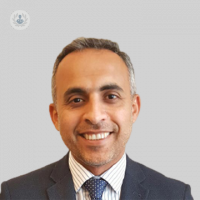Understanding benign prostate enlargement
Escrito por:Although prostate enlargement is a natural part of aging in men, it can often lead to bladder obstruction and have more sinister effects on one’s health and well-being. Esteemed consultant urological surgeon Mr Mohamed Ismail, who practices in Havant and Portsmouth, discusses this condition, its causes, and how it is treated both non-surgically and surgically.

What exactly is a benign prostate enlargement?
The prostate is a small gland that sits underneath the bladder in males. Its main function is to produce the fluid which, along with sperm, makes up semen. As men age past 50, the gland starts to enlarge and this is called benign prostatic enlargement. As the prostate enlarges, it puts pressure on the exit of the bladder. As a result, it becomes difficult to empty the bladder and pass urine.
What are the main symptoms?
The main symptoms of benign prostatic enlargement include difficulty in starting the urinary flow, increased urinary frequency, poor flow, peeing that stops and starts again, the urgent need to urinate, urinary leakage, and interrupted sleep due to the need to get up several times during the night to pee.
What are the known main causes of benign prostate enlargement?
The main causes of benign prostatic enlargement are mainly aging. The prostate is exposed to high levels of testosterone throughout life, which will cause the benign tissue in the prostate to increase in size. This puts pressure on the urethra, resulting in difficulties emptying the bladder.
When is the condition serious? When is emergency treatment required?
Benign prostate enlargement can have quite a significant impact on the patient’s quality of life. Many people seek medical advice when they start to have symptoms. However, the prostate can become so enlarged that it results in complete blockage of the bladder, causing urinary retention, which requires emergency treatment and urinary catheter insertion. It can also cause increased pressure in the bladder, which can affect the kidney, leading to renal failure.
When is surgery required, and what are the most effective non-surgical treatment alternatives?
When treating benign prostate enlargement, we always start with medical therapy. There are two main medications we use for the condition; tamsulosin and finasteride. Tamsulosin relaxes the muscle in the prostate and improves the urinary flow. Finasteride will shrink the tissue within the prostate. Both can be up to sixty percent effective in treating the condition.
If medical treatment fails, however, surgical intervention will be required. This can range from a minimally invasive treatment called “Rezum” up to transurethral resection of the prostate or holmium laser enucleation of the prostate (HoLEP). These tend to be definite management for the condition compared to medical therapy. Alternatively, if the patient isn’t keen on these options, then the long-term treatment will be a urethral catheter or intermittent self-catheterisation.
If you’re experiencing any of the above-mentioned symptoms and would like to book a consultation with Mr Mohamed Ismail, you can do so by visiting his Top Doctors profile.



